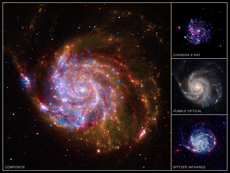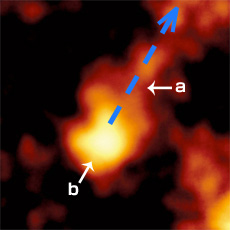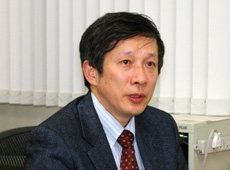Q. How do you view the role of X-ray observation?

Galaxy 101. In astronomy, the universe is observed at different wavelengths. On the right, from top to bottom, the images are from X-ray, visible light and radio-wave observation. On the left is a composite image of the three. (courtesy: X-ray: NASA/CXC/JHU/K.Kuntz et al.; Optical: NASA/ESA/STScI/JHU/K. Kuntz et al; IR: NASA/JPL-Caltech/STScI/K. Gordon)
In astronomy, the universe is observed using electromagnetic radiation with different wavelengths: radio waves, infrared, visible light, X-rays and gamma rays. The different types of radiation allow us to observe different kinds of phenomena. X-rays and gamma rays give us a window into extremely hot regions – those with a temperature of millions to hundreds of millions degrees Celsius – in other words, high-energy regions such as stellar explosions and black holes. X-ray astronomy was born when we learned how to launch instruments into space, and it taught us how intense and dynamic the universe is. This was completely different from what we had seen with our eyes. It was a world that no one had ever imagined. So I would say that X-ray observation has changed our outlook on the universe.
X-rays allow us to observe supernova remnants, hot gases in galaxy clusters, black holes, and neutron stars. Galaxy clusters are the largest structures in the universe, and studying their evolution is essential to grasping the entire historical picture. Hot gases trapped in a galaxy cluster are undetectable with visible light, we can observe them with X-rays. This allows us to find the distribution of dark matter, which makes up a major part of galaxy clusters. To research the formation and structure of the universe – how dark matter has aggregated and how galaxies and galaxy clusters were formed – X-ray observations are a necessity.
Q. What are the challenges of observing X-rays and gamma rays in space?
It is very difficult to make a highly accurate detector for X-rays and gamma rays emitted from an extremely dim object.
In studying X-rays, you have to distinguish between two types: hard and soft. ASTRO-H will have an onboard detector for each of them.
“Soft” x-rays, with a wavelength of 0.1–10 nanometers (nm), have lower energy than other X-rays, do not penetrate objects, and are not refractive enough to collect with a normal lens or a reflecting telescope. However, they can be reflected when they fall very close to a smooth metal surface, so we are making a specially shaped telescope to collect these rays specifically.
“Hard” X-rays have a high-energy wavelength of 0.01 to 0.1 nm. ASTRO-H will carry the world’s first telescope that can collect hard X-rays. These focused X-rays will be observed by highly advanced focal plane detectors.
The spacecraft will also carry another piece of original Japanese technology: a super-sensitive gamma ray detector. This way we can cover a wide energy spectrum, from X-rays to gamma rays. I think we’ll be able to create the world’s highest-performance detectors for ASTRO-H, thanks to the technologies and techniques we’ve accumulated over many years.
Q. Do you have a collaborative relationship with universities and other research institutes?

(a) A plasma stream coming from the centre of the Milky Way galaxy at a temperature of 10 million degrees Celsius, and (b) its source, a “plasma lake.” This region is hard to detect in X-rays due to its faint structure, but was discovered thanks to Suzaku’s high resolution. (courtesy: Tsuru et al. PASJ, 61, S219-S223 (2009) )
With the JAXA Institute of Space and Astronautical Science (ISAS) as the base, we have formed a large international team consisting of universities and research institutes across Japan and scientists abroad – in the United States, Europe, Canada, etc. Soon after ASTRO-H is launched, we will announce international observation opportunities, and anyone will be able to propose a project. ASTRO-H will have capabilities no other X-ray astronomy satellite has had before, and by the time ASTRO-H is launched, most other X-ray astronomy satellites currently in operation will retire, Hence there is tremendous interest and anticipation worldwide for our satellite.
Japan has launched five X-ray satellites to date, and has a good track record in this field. We have a strong, world-leading X-ray astronomy community. We’ve brought together a strong team of scientists with different specialties: cosmology, black holes, cutting-edge detectors, etc. It would be impossible to complete ASTRO-H without the efforts of all these people. So, in that sense, this project belongs not only to JAXA but also to all the scientists participating from overseas.
Q. What is special about Japanese X-ray astronomy satellites?
The United States has specialized in high-resolution imaging using low-energy X-rays. In contrast, Japan has taken a different approach by enhancing energy resolution using high-energy X-rays. So Japan has chosen to focus on highly sensitive spectral observation, instead of high-resolution imaging.
To get a high quality X-ray image of an object, you need a heavy, well-polished mirror with high angular resolution. Europe and the U.S. were ahead in this technology, and besides, it was not easy to make a satellite to accommodate such a heavy telescope. So Japan looked for a way to exceed them: we started making telescopes and instruments that had moderate angular resolution but were capable of detecting higher energy X-rays and more accurately determining their energy. The strategy worked. Japan has come to be at the forefront of many new sciences, as we have continued to launch original X-ray astronomy satellites equipped with compact but powerful detectors.
Japan’s X-ray satellites are: HAKUCHO in 1979, TENMA in 1983, GINGA in 1987, ASUKA in 1993, and Suzaku, which is currently in operation, in 2005. All of them have made great achievements, and their data has generated many research papers in prestigious academic journals, including Nature and Science.
Q. What is the attraction of X-ray astronomy for you?

Among the phenomena occurring in the universe, I like seeing high-energy regions. I started out studying elementary particles, so I’m interested in phenomena where something is born in high-energy conditions. In space, you can selectively look at an extreme environment using X-rays or gamma rays. It is also fascinating to see new aspects of the universe no one has ever seen before, and even to be able to conduct world’s-first observations, using instruments we ourselves helped build.
And the attraction of astronomy in general is the potential to solve the fundamental questions of existence: how the universe has evolved; why it has evolved this way; how life was born there; and where we are heading. With astronomy, it may become possible to describe the answers to these questions in scientific terms. The universe continues to attract us with countless mysteries.
Q. Finally, please tell us about your passion for ASTRO-H.
ASTRO-H is carrying everyone’s wishes to achieve what has up to now been impossible, and what many people have wanted to accomplish. Scientists around the world are looking forward to this mission, so we don’t have much choice but to just do it. Everyone’s focus is to put our efforts together and complete and launch ASTRO-H as early as possible. Our ASTRO-H team is very strong.
I think there are many challenges to overcome before we can complete ASTRO-H, but the reward will be world’s-first outcomes. I get excited just thinking about it.
Professor, Department of High Energy Astrophysics, Institute of Space and Astronautical Science, JAXA
Dr. Takahashi graduated from the Department of Physics, Faculty of Science at the University of Tokyo in 1982. He received his Ph.D. at the Graduate School of Science at the University of Tokyo in 1987. After working as a research associate at the University of Tokyo, he became associate professor at ISAS (now part of JAXA) in 1995, and was engaged in research using the X-ray astronomy satellite ASCA. He was appointed professor of the same institute in 2001, and worked on the development of the hard X-ray detector on board Suzaku, which was launched in 2005. He has been project manager of the X-ray astronomy satellite ASTRO-H since 2008. His specialty is high energy astrophysics.
Discovering the Relationship Between Black Holes and Galaxy Formation | Probing the Evolution of the Universe with Galaxy Clusters | Hopes for New Images of the Universe | ASTRO-H Outline
Spin-off Technologies from ASTRO-H | History of Japanese X-ray Astronomy Satellites